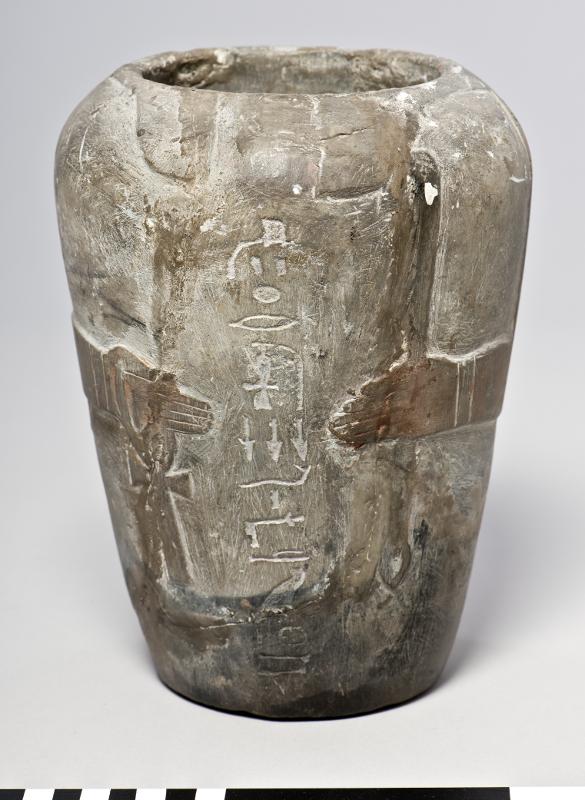| Typ <itemType> |
Objekt/föremål |
| Datering <presTimeLabel> |
Middle Kingdom - New Kingdom (2061-1081 BC) |
| Plats <presPlaceLabel> |
Afrika, Egypten |
| Description <itemDescription> |
|
| Inventory number <itemDescription> |
|
| Acquisition <itemDescription> |
|
| Comments <itemDescription> |
-
Additional marking, a paper sticker: N. Tano Antiquities, no.646, Cairo-Egypt.
On loan 1928-1933 from the donor.
|
| Comments <itemDescription> |
|
| Condition <itemDescription> |
|
| Period, Swedish <itemDescription> |
|
| Publications <itemDescription> |
-
Peterson, B. J., Ausgewählte ägyptische Personennamen nebst prosopographischen Notizen aus Stockholmen Sammlungen, OrSu, vol. XIX-XX, (1970-1971), p.8, fig.7
|
| Utställning / ingår i <itemDescription> |
|
| Country / Findspot <itemDescription> |
|
| Exhibition, Part of / Current <itemDescription> |
|
| Loan out / Previously <itemDescription> |
|
| Name / Loantaker <itemDescription> |
|
| Description, Swedish <itemDescription> |
|
| Acquisition, Swedish <itemDescription> |
|
| Exhibition, showcase / Current <itemDescription> |
|
| Egyptenutställningen 2014, English / Label <itemDescription> |
-
Canopic jars with lids. The canopic jars were used to store the embalmed inner organs. The lids were shaped as human heads or in the form of the gods that were the protectors of the organs: Hapi (babo...
Visa hela
Canopic jars with lids. The canopic jars were used to store the embalmed inner organs. The lids were shaped as human heads or in the form of the gods that were the protectors of the organs: Hapi (baboon) protected the lungs; Duamutef (jackal) the stomach; Imsety (human) liver and Qebehsenuef (falcon) the intestines. The vessels in the case are from different time periods and places.
Stäng
|
| Egyptenutställningen 2014, Swedish / Label <itemDescription> |
-
Kanopkärl och lock. I kanopkärlen förvarades de balsamerade inre organen. Locken utformades som människohuvuden eller som de gudar som skyddade organen: Hapi (babian) skyddade lungorna, Duamutef (sjak...
Visa hela
Kanopkärl och lock. I kanopkärlen förvarades de balsamerade inre organen. Locken utformades som människohuvuden eller som de gudar som skyddade organen: Hapi (babian) skyddade lungorna, Duamutef (sjakal) magen, Imsety(människa) levern och Qebehsenuef (falk) inälvorna. Kärlen i montern kommer från olika tider och platser.
Stäng
|
| Händelse <context> |
-
Förvärvad av Smith, Otto.
-
Brukad Middle Kingdom - New Kingdom (2061-1081 BC).
-
Funnen i Egypten, Afrika.
|
| Material, engelska<itemMaterial> |
- Stone
- Limestone
|
| Material<itemMaterial> |
- Kalksten
- Sten
|
| Nyckelord <itemKeyWord> |
-
E.S. 10
-
Middle Kingdom - New Kingdom (2061-1081 BC)
-
New Egypt
-
Samlingsbesök. 2025-06-02-2025-06-03. Kanopkärl
|
| Mått <itemMeasurement> |
-
Height / Höjd: 23,5 cm.
-
Diameter: 17,5 cm.
|
| Object, Swedish<itemName> |
- kanopkärl
|
| Object<itemName> |
- canopic jar
|
| Ämne <subject> |
|
| Inventory number <itemNumber> |
|
| Previous ID <itemNumber> |
|
| Egypt, Number in Exhibition <itemNumber> |
|
| Rättigheter för metadata <itemLicense> |

|
| Källa <presOrganization> |
Statens museer för världskultur - Medelhavsmuseet |
|
Källa <url>
|
|







 ARTIKLAR I WIKIPEDIA
ARTIKLAR I WIKIPEDIA ARTIKLAR I WIKIDATA
ARTIKLAR I WIKIDATA BILDER I WIKIMEDIA COMMONS
BILDER I WIKIMEDIA COMMONS







